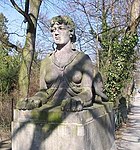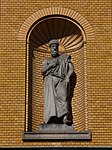Max Klein (sculptor)
Max Klein (born January 27, 1847 in Gönc , Abaúj-Torna County ; † September 6, 1908 in Grunewald near Berlin ) was a German sculptor and medalist .
Life

Max Klein grew up in poor conditions as the son of Jewish parents. After leaving school, he first learned the watchmaking trade and then worked in the Pest workshop of the sculptor Ferenc Szandház and his brother and colleague Károly Szandház . From 1865 Klein studied for a short time at the Royal Prussian Academy of the Arts in Berlin, which he had to leave for financial reasons. In 1869 Max Klein went to Rome for further training, where he joined the German Artists' Association, of which he was a member until 1870. Via Breslau, Vienna and Munich he went to Berlin in 1874 and worked there at the Berlin Art Academy in the studio of the painter Carl Steffeck . After a second trip to Rome, he was one of the first residents of the Grunewald villa colony to live permanently in Berlin. In 1886 Klein became naturalized and in the same year married Eva Dohm, the youngest daughter of the editor-in-chief of the satirical newspaper “ Kladderadatsch ”, Ernst Dohm , and the writer Hedwig Dohm . Max and Eva Klein's daughter Mira , born in 1886, was married to the psychologist Kurt Koffka from 1909 to 1923 . In 1901 Max Klein was awarded the Prussian professor title.
plant
Klein made his debut at the Berlin academy exhibition in 1877 with a plaster model of the fountain figure of Fischer's dream , but it was not until his bronze group Hercules, wrestling with the Nemean lion, created in 1879, that he caused a sensation in art circles. In contrast, another early work in the style of neo-baroque realism , The Anachoret , received less approval. The bronze group Fürst Bismarck with his dog Tyras for Bismarckplatz in Berlin-Grunewald, which was completed in 1897 and was regarded as a battle cry against academism at the time , was also well received . His marble figure Loreley , which an art lover acquired in 1899 and donated to the Prussian state, was displayed in the "beautiful fountain" in the pillared courtyard in front of the Alte Nationalgalerie . In 1900 he took part in the Great Berlin Art Exhibition with the Simson statue , bound and blinded . Max Klein was unable to finish his last work, a memorial in honor of the writer Theodor Fontane . After his death in 1908, Fritz Schaper completed the standing figure, which was unveiled two years later on the edge of the Berlin zoo . A copy in artificial stone now replaces the original, which is on deposit in the Great Hall of the Märkisches Museum . In addition to working on free-standing sculptures and groups, his preference was for decorative building and bridge sculptures as well as portrait busts.
After the academy exhibition, he was commissioned to make two niche figures of the philosophers Plato and Aristotle for the front of the Joachimsthal School in Berlin-Wilmersdorf , which he made in sandstone in 1881 . Eight reliefs depicting the battle between the hydraulic engineer and the forces of the deep were attached to the Kronprinzenbrücke in Berlin's Mitte district, which had not survived from 1877 to 1879 , and vases, obelisks and sphinxes made of red sandstone have adorned the Bismarck Bridge in the villa colony from 1897 to this day Grunewald. In collaboration with other sculptors, Max Klein was also involved in decorating the Potsdamer Bridge in Berlin-Tiergarten . Of the four bronze sculptures of well-known scientists sitting on the bridgeheads, he created the figure of the physicist Hermann von Helmholtz in 1898 . The works of art executed in the Lauchhammer art foundry were melted down in 1942 for armament purposes. Max Klein also created other architectural jewelry for the south portal of the Reichstag building with the allegory group The Strength and a figure frieze Raising the German Genius on 1882-1884 by the Berlin architects Gustav Ebe and Julius Benda, Palais Mosse , Leipziger Platz 15. He was also involved in the decoration of the New building of the Kaiser-Wilhelms-Akademie on Invalidenstrasse (today the seat of the Federal Ministry of Economics and Technology ) was added, where he worked on the architectural sculpture in collaboration with Otto Lessing and Albert Manthe from 1903.
From the busts he commissioned, he made the portraits of the Prussian General August von Werder and the Prussian Field Marshal Edwin von Manteuffel for the Berlin Hall of Fame . He designed others by the cellist David Popper , the philosopher Friedrich Nietzsche , the writer Theodor Fontane, the philosopher Fritz Mauthner , the doctor James Israel , the poet Stefan George and a few more. A replica of the bust of Klein's wife was bought by the Austrian Empress Elisabeth in 1887 .
“Although K. [lein] wanted to see himself placed in a fundamental opposition to the direction of R. Begas , his style - virtuoso modeling, which is expressed in particular in the reproduction of the material - and the graceful, somewhat overly amiable conception fit in of his female figures [...] but casually follows the direction of the gas school prevailing in Berlin at the turn of the century. "
gallery
Hercules with the Nemean Lion , 1879, Bodestrasse 1–3, Berlin-Mitte
Sphings at the Bismarck Bridge in Berlin-Grunewald , 1897
Bismarck monument in Berlin-Grunewald, 1897. Photo taken around 1900 with the original melted down during World War II, which was replaced in 1996 by a re-creation by Harald Haacke .
literature
- Adolph Kohut : Professor Max Klein, Berlin. In: German Art and Decoration , year 1904, pp. 637–641. ( Digitized version )
- Károly Lyka : Small, Max . In: Hans Vollmer (Hrsg.): General lexicon of fine artists from antiquity to the present . Founded by Ulrich Thieme and Felix Becker . tape 20 : Kaufmann – Knilling . EA Seemann, Leipzig 1927, p. 444-445 .
- Klein Max. In: Austrian Biographical Lexicon 1815–1950 (ÖBL). Volume 3, Verlag der Österreichischen Akademie der Wissenschaften, Vienna 1965, p. 384.
- Elga Eberhardt: Max Klein (1847–1908). A sculptor in the Wilhelmine era. (Dissertation, Freie Universität Berlin 1992) Microfiche edition, Berlin 1993.
Web links
Individual evidence
- ^ L. Forrer: Biographical Dictionary of Medallists . Klein, Max. Volume VII. Spink & Son Ltd., London 1923, pp. 508 .
- ^ Peter Bloch: Bildwerke 1780–1910. Sculpture Gallery and National Gallery Berlin. Volume 3, Gebr. Mann, Berlin 1990, ISBN 3-7861-1565-6 , p. 80.
- ↑ a b c Károly Lyka: Klein, Max . In: Hans Vollmer (Hrsg.): General lexicon of fine artists from antiquity to the present . Founded by Ulrich Thieme and Felix Becker . tape 20 : Kaufmann – Knilling . EA Seemann, Leipzig 1927, p. 444-445 .
-
^ Art Chronicle , New Series, Volume 21, No. 28 (from June 3, 1910), p. 456.
The monument was actually only unveiled at the end of May 1910, after long discussions about the location.
| personal data | |
|---|---|
| SURNAME | Small, max |
| BRIEF DESCRIPTION | German sculptor and medalist |
| DATE OF BIRTH | January 27, 1847 |
| PLACE OF BIRTH | Gönc , Abaúj-Torna county |
| DATE OF DEATH | September 6, 1908 |
| Place of death | Grunewald near Berlin |




